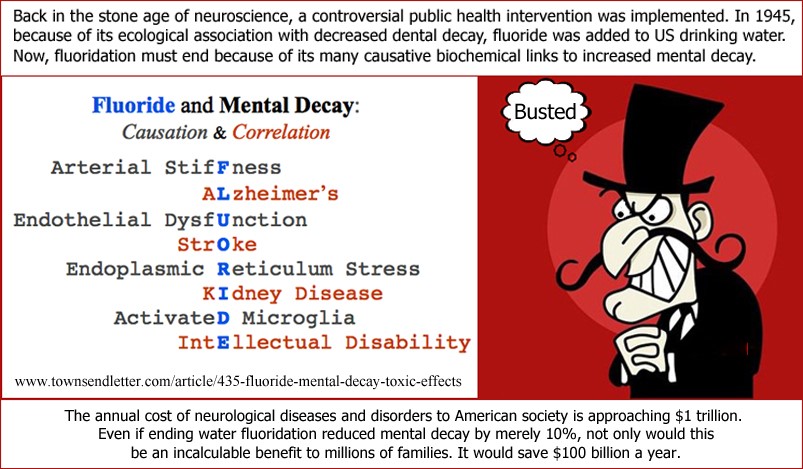John D. MacArthur

Back in the stone age of neuroscience, a controversial public health intervention was implemented. In 1945, because of its ecological association with decreased dental decay, fluoride was added to US drinking water. Now, fluoridation must end because of its many causative biochemical links to increased mental decay.
Well-established molecular mechanisms of fluoride toxicity are oxidative stress and inflammation, whose involvement in the initiation and pathogenesis of Alzheimer’s disease is now being recognized.1
More recently, increasing scientific evidence reveals fluoride’s pathological role in major neurodegenerative pathways: arterial stiffness, endothelial dysfunction, ER stress, and microglial activation.
Arterial Stiffness
The biological aging process is always associated with arterial stiffness, which is emerging as an important risk factor underlying the effect of blood pressure on the brain. Arterial stiffness correlates with the pathogenesis of a large spectrum of vascular disorders: hypertension, stroke, kidney dysfunction, cerebrovascular disease, dementia, and Alzheimer’s disease. The extent and progression of β-amyloid deposition in the brain is associated with arterial stiffness.2
When arteries lose their elasticity, it impairs their ability to absorb the increased pressure generated as the heart ejects blood into them. This arterial-pressure pulsatility is instead transmitted to smaller blood vessels. The brain’s hippocampus is articularly vulnerable, because its capillaries are located close to large vessels. Swedish researchers have outlined a sequence of vascular events, connecting arterial stiffness to damaged hippocampal capillaries and impaired memory in older adults.3
In people with fluorosis, the elastic properties of the ascending aorta are impaired.4 Fluoride accelerates arterial calcification and stiffening that lead to hypertension. When fluoride levels in drinking water increased from 0.84 to 1.55 mg/L, hypertension prevalence increased 22%.5
Population studies have found statistically significant positive correlations between fluoride levels in drinking water and increased hypertension, as well as a significant relationship with increased blood pressure.6
Impaired elasticity of the ascending aorta is associated with subclinical hypothyroidism. Higher TSH levels, a measure of hypothyroidism, correlate with aortic stiffness.7 Data from nearly 8,000 medical practices in England revealed a positive association between patients diagnosed with hypothyroidism and fluoride levels in their drinking water. Those living in a fluoridated region had twice the hypothyroidism prevalence as those in a nonfluoridated one.8
This study did not include undiagnosed subclinical hypothyroidism, which the US National Research Council (2006) said is associated with “cognitive dysfunction,” as well as with “increased cholesterol concentrations.”9 In May 2019, JAMA Neurology reported a link between high LDL cholesterol levels and early-onset Alzheimer’s disease.10 Several animal studies have shown that fluoride exposure increases LDL cholesterol levels.
Endothelial Dysfunction
Endothelial cells line the inside of blood vessels from the aorta to microvessels, where they form a selective blood-tissue barrier that protects every organ system. Microvascular endothelial cells play a critical role in brain development, maturation, and homeostasis. Endothelial cell dysfunction in the blood-brain barrier is the first pathological change in the development of small vessel disease (SVD), the leading cause of vascular dementia. SVD contributes to and worsens the symptoms of Alzheimer’s disease, triples the risk of stroke, and is responsible for up to 45% of dementias.11
Researchers at Johns Hopkins University School of Medicine demonstrated that sodium fluoride causes “dramatic” endothelial barrier dysfunction, as evidenced by marked increases in macromolecule endothelial cell permeability.12
Sevoflurane is a general anesthetic that significantly increases blood fluoride levels. After exposure to sevoflurane, the blood-brain barrier is compromised due to “flattening of endothelial cell surfaces.”13,14
Sevoflurane is associated with high rates of post-operative delirium, a common and often fatal disorder affecting as many as 50% of older people during surgery or hospitalization. The severity of this delirium correlates directly to the severity of later cognitive impairment and decline.15
Another fluorinated drug that increases blood levels of fluoride and causes endothelial cell dysfunction is 5-fluorouracil.16,17
African Americans have reduced endothelial function – and greater arterial stiffness – compared with whites, even after adjusting for traditional cardiovascular risk factors.18
ER Stress
Within a cell, the endoplasmic reticulum (ER) is the site where proteins are synthesized and folded. ER function is highly sensitive to toxins that can overwhelm the cell’s folding capacity and cause misfolded proteins to accumulate, a condition known as ER stress.
Chronic ER stress is responsible for neurodegeneration in numerous human diseases whose pathology includes accumulation of misfolded proteins in the brain. In Alzheimer’s disease, the ER is “drastically affected.”19,20 In addition, mounting proof indicates that ER stress is incriminated in psychiatric diseases like major depressive disorder, bipolar disorder, and schizophrenia.21
Fluoride exposure induces excessive ER stress and associated cell death in the hippocampus of rats, resulting in histological and ultrastructural abnormalities that impair learning and memory capabilities.22
Damaged tooth enamel is called dental fluorosis, because it is caused by fluoride, which initiates an ER stress response during tooth development. Beginning with the lowest dose tested, researchers at the Forsyth Institute observed an increase in the magnitude of ER stress with increasing doses of fluoride.23
In skeletal fluorosis, fluoride causes ER stress during osteoblast maturation. The severity of osteofluorosis is associated with accumulation of fluoride in bone in a dose-dependent manner.24,25
Microglial Activation
Microglia are a type of immune cell that account for about 10% of all brain cells. An essential function of microglia is to defend the brain against toxins. When activated, microglia produce neuroinflammation that can damage and kill neurons. Microglial activation is involved in the development and progression of a variety of neurodegenerative diseases, including Alzheimer’s, Parkinson’s, Huntington’s, and Lou Gehrig’s.26 Only recently is it becoming clear that brain microglia are also key regulators of the developing brain.27
Fluoride is able to cross the blood-brain barrier and accumulate in neurons, affecting many biochemical mechanisms. Fluoride exposure has been shown to activate microglia and increase inflammation in the central nervous system which leads to neurodegeneration.28
Postsynaptic density protein-95 (PSD-95) is concentrated in the trillions of tiny synapses that allow neurons to communicate with each other. PSD-95 orchestrates synaptic development and plays an important role in synaptic plasticity, the basis of learning and memory.
When rats were sub-chronically exposed to fluoride in their drinking water, researchers found that fluoride activated microglia and decreased levels of PSD-95 in the brain’s hippocampus. They concluded that “the role of fluoride on synaptic plasticity may be associated with neuroinflammation induced by microglia.”29
Another study found that the fluidity of synaptic membranes and the expression level of PSD-95
decreased gradually with increasing fluoride concentration, indicating that “decrease of synaptic
membrane fluidity and PSD-95 expression level may be the molecular basis of central nervous
system damage caused by fluoride intoxication.”30
Rats anesthetized for 4 hours with 2.5% sevoflurane showed decreased PSD-95 expression and longterm deficits in hippocampal function. Seven weeks after exposure, they had significant spatial learning and memory impairment, suggesting that “sevoflurane causes neurotoxicity in the developing brain, which may be attributed to decreased PSD-95 in the hippocampus.”31 In humans, exposure to 2.4% sevoflurane significantly increases serum fluoride levels.13
Fluoridation’s Ecological Correlations
Fluoride’s multiple causative biochemical links to mental decay are reinforced by numerous ecological associations with leading causes of death and with prevalence rates of neurodevelopmental disorders.
Alzheimer’s Disease
In 2019, a large longitudinal study found a dose-response pattern of association between dementia in women and men who consumed relatively low drinking-water levels of fluoride. The dementia risk more than doubled in the highest quartile compared with the lowest.32
US death rates in 2013 from Alzheimer’s disease (sixth leading cause of death) averaged 9% higher in the 20 states whose public water supplies were more than 80% fluoridated (avg. 93% in 2012), compared to the 30 states fluoridated below 80% (avg. 58%).33,34
In the 10 most fluoridated states (avg. 97%), Alzheimer’s death rates averaged 25% higher than in the 10 least fluoridated states (avg. 35%).
Hypertension and Stroke
Hypertension is a major cause of vascular cognitive impairment and is the single most important modifiable risk factor for adult stroke (cerebral vascular disease). Stroke doubles the chances of developing dementia.35,36
The rate of chronic hypertension among pregnant women over age 34 increased more than 75% from 1970 to 2010. (During the same 40 years, the percentage of US population receiving fluoridated water increased 51%.) The rate of persistent high blood pressure in black women was more than twice the rate of white women.37
In the 10 most fluoridated states, death rates from hypertension (thirteenth leading cause) averaged 13% higher. Death rates from stroke (fifth leading cause of death) averaged 6% higher than in the 10 least fluoridated states.33,34
Kidney Disease
The US Public Health Service has long known: “Subsets of the population may be unusually susceptible to the toxic effects of fluoride and its compounds. These populations include the elderly, people with osteoporosis, people with deficiencies of calcium, magnesium, vitamin C, and/or protein, and people with kidney problems.”38 The number of Americans unusually susceptible to fluoride’s toxicity now far outnumber children with developing dentition, the claimed beneficiaries of fluoridation.
Cognitive decline is one of many manifestations of brain damage that clearly accompany the decline of kidney function, even in early stages.39
Kidney disease death rates (ninth leading cause) averaged 13% higher in the 20 states more than 80% fluoridated, compared to the 30 states fluoridated below 80%.33,34
In the 10 most fluoridated states, death rates from kidney disease averaged 26% higher than in the 10 least fluoridated states.
Attention-Deficit Hyperactivity Disorder (ADHD)
The most common neurodevelopmental disorder of childhood is ADHD. Each one-percent increase in artificial fluoridation prevalence in the US was associated with 67,000 to 131,000 additional ADHD diagnoses (2003 to 2011).40
In 2011, rates for youth (aged 4-17) currently diagnosed with ADHD averaged 25% higher in the states fluoridated at 80% or more, compared to those below 80% in 2010.33,41
Mental Retardation/Intellectual Disability
In 1993, mental retardation prevalence rates averaged 33% higher for children (aged 6-17) in the 26 states fluoridated above the national average (62% in 1992) compared to the 24 states fluoridated below it.42,43
By 2012, it had nearly doubled. The prevalence rates of “intellectual disability” (the new term for mental retardation) averaged 57% higher for students (aged 6-21) in the 26 states fluoridated above the national average (75% in 2012) compared to the 24 states fluoridated below it.33,44
In the 10 most fluoridated states, intellectual disability prevalence averaged 84% higher than in the 10 least fluoridated states.
Preterm Birth
In 2009, a well-designed New York State public health study found that water fluoridation was independently associated with a 15% increased risk of preterm birth.45 No follow-up research was done, even though two years earlier the US Institute of Medicine reported: “Those born preterm have an appreciable risk of long-term neurological impairment.”46 And even though three years earlier, the National Research Council said “decreased IQ of their offspring” is associated with fluoride’s adverse effects on the thyroid gland of pregnant women.9
Since 2009, a team of researchers at the EPA’s Neurotoxicology Division continues to find substantial evidence that fluoride is a “Developmental Neurotoxicant,” one of 22 gold standard chemicals “well documented to alter human neurodevelopment.” Others include aluminum, arsenic, alcohol, lead, and mercury.47
Despite the rapidly growing body of substantial evidence, fluoridationists continue to reject anything that threatens their commitment to protecting fluoride – including a meticulously peer- reviewed US government-funded study published by JAMA Pediatrics in August 2019. This multicenter birth cohort study included mother-offspring pairs in fluoridated and non-fluoridated cities in Canada. It found: “A 1-mg higher daily intake of fluoride among pregnant women was associated with a 3.66 lower IQ score in boys and girls” – confirming what three other studies in the last two years revealed: babies in the womb are the most vulnerable to fluoride’s neurotoxicity.48
Fluoridation Must End
It’s important to minimize fluoride consumption, but this is very difficult because fluoridation chemicals (increasingly, waste products from China) are intentionally added to about 75% of US tap water. An EPA-regulated “water contaminant,” fluoride now contaminates the nation’s processed food-and-beverage chain. Products produced in a fluoridated city still contain fluoride even if the label says “filtered water” (unless specifically filtered by reverse osmosis).
The amount of fluoride we consume is unknown, because manufacturers and producers still do not provide information on the fluoride content of commercial foods and beverages, even though in 2006 the National Research Council said they should do so. This extremely comprehensive report’s dozens of recommendations have been ignored, including:
“Studies of populations exposed to different concentrations of fluoride should be undertaken to evaluate neurochemical changes that may be associated with dementia. Consideration should be given to assessing effects from chronic exposure, effects that might be delayed or occur late-in-life, and individual susceptibility.”48
The annual cost of neurological diseases and disorders to American society is approaching $1 trillion. Even if ending water fluoridation reduced mental decay by merely 10%, it would not only be an incalculable benefit to millions of families. It would save $100 billion a year.
John D. MacArthur’s previous contributions to the Townsend Letter
include five reports: “Too Much Copper, Too Little Zinc, and Cognitive
Deterioration in Alzheimer’s Disease” (with George J. Brewer, MD), and
“Overdosed: Fluoride, Copper, and Alzheimer’s Disease” (October 2013);
“Fluoride and Preterm Birth” (November 2013); “Placental Fluorosis:
Fluoride and Preeclampsia” (May 2015); and “Prenatal Fluoride and
Autism” (April 2016).
Links to his other writings are at johndmacarthur.com.
References
1. Goschorska M, Baranowska-Bosiacka I, Gutowska I, et al. Potential role of fluoride in the etiopathogenesis of Alzheimer’s disease . Int J Mol Sci. 2018 Dec 9;19(12).
2. Hughes TM, Craft S, Lopez OL. Review of ‘the potential role of arterial stiffness in the pathogenesis of Alzheimer’s disease’ . Neurodegenerative Disease Management. 2015;5(2):121-135.
3. Umea University. Brain takes a beating as arteries age . August 20, 2019.
4. Varol E, Akcay S, Ersoy IH, et al. Aortic elasticity is impaired in patients with endemic fluorosis . Biol Trace Elem Res. 2010 Feb;133(2):121-127.
5. Sun L, Gao Y, Liu H, et al. An assessment of the relationship between excess fluoride intake from drinking water and essential hypertension in adults residing in fluoride endemic areas . Total Environ. 2013 Jan 15;443:864-869.
6. Amini H, Taghavi Shahri SM, Amini M, et al. Drinking water fluoride and blood pressure? An environmental study . Biol Trace Elem Res. 2011 Dec;144(1-3):157-163; Yousefi M, Yaseri M, Nabizadeh R, et al. Association of hypertension, body mass index, and waist circumference with fluoride intake; water drinking in residents of fluoride endemic areas, Iran . Biol Trace Elem Res. 2018 Oct;185(2):282-288.
7. Yurtdas M, Gen R, Ozcan T, Aydin MK. Assessment of the elasticity properties of the ascending aorta in patients with subclinical hypothyroidism by tissue Doppler imaging . Arq Bras Endocrinol Metabol. 2013 Mar;57(2):132-138.
8. BMJ. Water fluoridation in England linked to higher rates of underactive thyroid . February 23, 2015; Peckham S, Lowery D, Spencer S. Are fluoride levels in drinking water associated with hypothyroidism prevalence in England? A large observational study of GP practice data and fluoride levels in drinking water. J Epidemiol Community Health. 2015;0:1-6.
9. National Research Council. Effects on Thyroid Function . Fluoride in drinking water: A scientific review of EPA’s standards. National Academies Press; 2006. Page 236.
10. Veterans Affairs Research Communications. High LDL linked to early-onset Alzheimer’s . May 28, 2019.
11. Rajani RM, Quick S, Ruigrok SR, et al. Reversal of endothelial dysfunction reduces white matter vulnerability in cerebral small vessel disease in rats . Sci Transl Med. 2018 Jul 4;10(448).
12. Wang P, Verin AD, Birukova A, et al. Mechanisms of sodium fluoride-induced endothelial cell barrier dysfunction: Role of MLC phosphorylation . Am J Physiol Lung Cell Mol Physiol. 2001 Dec;281(6):L1472-1483.
13. Goldberg ME, Cantillo J, Larijani GE, et al. Sevoflurane versus isoflurane for maintenance of anesthesia: are serum inorganic fluoride ion concentrations of concern? Anesth Analg. 1996 Jun;82(6):1268-1272.
14. Acharya NK, Goldwaser EL, Forsberg MM, et al. Sevoflurane and isoflurane induce structural changes in brain vascular endothelial cells and increase blood-brain barrier permeability: Possible link to postoperative delirium and cognitive decline . Brain Res. 2015 Sep 16;1620:29-41.
15. Hebrew SeniorLife Institute for Aging Research. Severity of post-operative delirium relates to severity of cognitive decline . November 28, 2017.
16. Hull WE, Port RE, Herrmann R, et al. Metabolites of 5-fluorouracil in plasma and urine ... Cancer Res. 1988 Mar 15;48(6):1680-1688.
17. Altieri P, Murialdo R, Barisione C, et al. 5-fluorouracil causes endothelial cell senescence: potential protective role of glucagon-like peptide 1 . Br J Pharmacol. 2017 Nov;174(21):3713-3726.
18. Morris AA, Patel RS, Binongo JN, et al. Racial differences in arterial stiffness and microcirculatory function between black and white Americans . J Am Heart Assoc. 2013 Apr 8;2(2):e002154.
19. Gerakis Y, Hetz C. Emerging roles of ER stress in the etiology and pathogenesis of Alzheimer’s disease . FEBS J. 2018 Mar;285(6):995-1011.
20. Mahdi AA, Rizvi SHM, Parveen A. Role of endoplasmic reticulum stress and unfolded protein responses in health and diseases . Indian J Clin Biochem. 2016 Apr; 31(2): 127-137.
21. Muneer A, Shamsher Khan RM. Endoplasmic reticulum stress: Implications for neuropsychiatric disorders . Chonnam Med J. 2019 Jan;55(1):8-19.
22. Niu Q, Chen J, Xia T, et al. Excessive ER stress and the resulting autophagic flux dysfunction contribute to fluoride-induced neurotoxicity . Environ Pollut. 2018 Feb;233:889-899.
23. Sharma R, Tsuchiya M, Bartlett JD. Fluoride induces endoplasmic reticulum stress and inhibits protein synthesis and secretion . Environ Health Perspect. 2008 Sep;116(9):1142-1146.
24. Zhou YL, Shi HY, Li XN, et al. Role of endoplasmic reticulum stress in aberrant activation of fluoride-treated osteoblasts . Biol Trace Elem Res. 2013 Sep;154(3):448-456.
25. Liu L, Zhang Y, Gu H, et al. Fluorosis induces endoplasmic reticulum stress and apoptosis in osteoblasts in vivo . Biol Trace Elem Res. 2015 Mar;164(1):64-71.
26. Massachusetts General Hospital. Regulating microglial activity may reduce inflammation in neurodegenerative diseases . October 17, 2018.
27. Lenz KM, Nelson LH. Microglia and beyond: Innate immune cells as regulators of brain development and behavioral function . Front Immunol. 2018 Apr 13;9:698.
28. Dec K, Lukomska A, Maciejewska D, et al. The influence of fluorine on the disturbances of homeostasis in the central nervous system . Biol Trace Elem Res. 2017; 177(2):224-234.
29. Yang L, Jin P, Wang X, et al. Fluoride activates microglia, secretes inflammatory factors and influences synaptic neuron plasticity in the hippocampus of rats . Neurotoxicology. 2018 Dec;69:108-120.
30. Zhu W, Zhang J, Zhang Z. Effects of fluoride on synaptic membrane fluidity and PSD-95 expression level in rat hippocampus . Biol Trace Elem Res. 2011 Feb;139(2):197-203.
31. Wang SQ, Fang F, Xue ZG, et al. Neonatal sevoflurane anesthesia induces long-term memory impairment and decreases hippocampal PSD-95 expression without neuronal loss . Eur Rev Med Pharmacol Sci. 2013 Apr;17(7):941-950.
32. Russ TC, Killin LOJ, Hannah J, et al. Aluminium and fluoride in drinking water in relation to later dementia risk . Br J Psychiatry. 2019 Mar 14:1-6.
33. US Centers for Disease Control & Prevention (CDC). Fluoridation Statistics. 2000-2014 . Percentage of state populations on community water systems receiving fluoridated water. Division of Oral Health. 2017.
34. Xu J, Murphy SL, Kochanek KD, Bastian BA. Deaths: Final Data for 2013 . National Vital Statistics Report. 2016 Feb 16;64(2):86-89. Table 19. Age-adjusted rate.
35. Kupferman JC, Zafeiriou DI, Lande MB, et al. Stroke and hypertension in children and adolescents . J Child Neurol. 2017 Mar;32(4):408-417.
36. Hachinski V, Einhaupl K, Ganten D, et al. Preventing dementia by preventing stroke: The Berlin Manifesto . Alzheimers Dement. 2019 Jul;15(7):961-984.
37. Rutgers University. High blood pressure among older pregnant women has increased by more than 75% since 1970 . September 9, 2019; CDC. Fluoridation Growth . 2016.
38. Public Health Service Agency for Toxic Substances and Disease Registry. Toxicological profile for fluorides, hydrogen fluoride, and fluorine . September 2003. Pages 162-163.
39. Viggiano D, Wagner CA, Blankestijn PJ, et al. Mild cognitive impairment and kidney disease: clinical aspects . Nephrology Dialysis Transplantation. 09 Apr 2019.
40. Malin AJ, Till C. Exposure to fluoridated water and attention deficit hyperactivity disorder prevalence among children and adolescents in the United States: an ecological association . Environ Health. 2015;14:17.
41. CDC. Percent of Youth Aged 4-17 with Current Attention-Deficit/Hyperactivity Disorder by State in 2011 . Division of Human Development and Disability. 2019.
42. US Department of Health & Human Services. Population and Percent Served with Fluoridated Water; 1992 . Fluoridation Census. September 1993. Page viii, Table 1.
43. CDC. State-Specific Rates of Mental Retardation. Prevalence rate of mental retardation, by state for children (6-17 years old) in 1993 . Table 1. MMWR. January 26, 1996;45(03):61-65.
44. The Iris Center. Disability awareness: State by state prevalence rates of disability categories. Intellectual Disability Prevalence for Students Aged 6-21 . 2012-2013 school year.
45. Hart R, Feelemyer J, Gray C, et al. Relationship between municipal water fluoridation and preterm birth in Upstate New York . American Public Health Association Meeting and Expo. November 9, 2009.
46. Institute of Medicine (US) Committee on Understanding Premature Birth and Assuring Healthy Outcomes; Behrman RE, Butler AS, editors. Appendix B: Prematurity at Birth: Determinants, Consequences, and Geographic Variation . Washington (DC): National Academies Press (US); 2007.
47. Mundy W, Padilla S, Shafer T, et al. Building a Database of Developmental Neurotoxicants: Evidence from Human and Animal Studies . Neurotoxicology Division. US EPA. 2009; Mundy WR, Padilla S, Breier JM, et al. Expanding the test set: Chemicals with potential to disrupt mammalian brain development . Neurotoxicol Teratol. 2015 Nov-Dec;52(Pt A):25-35.
48. Green R, Lanphear B, Hornung R, et al. Association between maternal fluoride exposure during pregnancy and IQ scores in offspring in Canada . JAMA Pediatr. 2019 Aug 19.; Fluoride Action Network. The 5 Mother-Offspring Fluoride Studies . August 2019.
49. National Research Council. Neurotoxicity and Neurobehavioral Effects. Fluoride in drinking water: A scientific review of EPA’s standards. National Academies Press; 2006. Page 223.
John D. MacArthur Fluoride and Mental Decay: Causation & Correlation ONLINE Sep. 11, 2019










